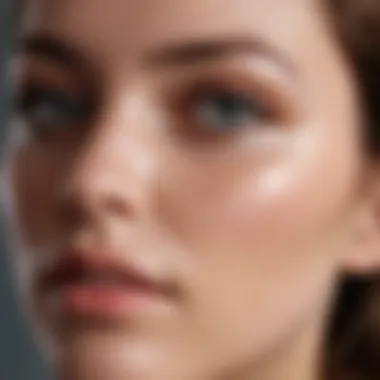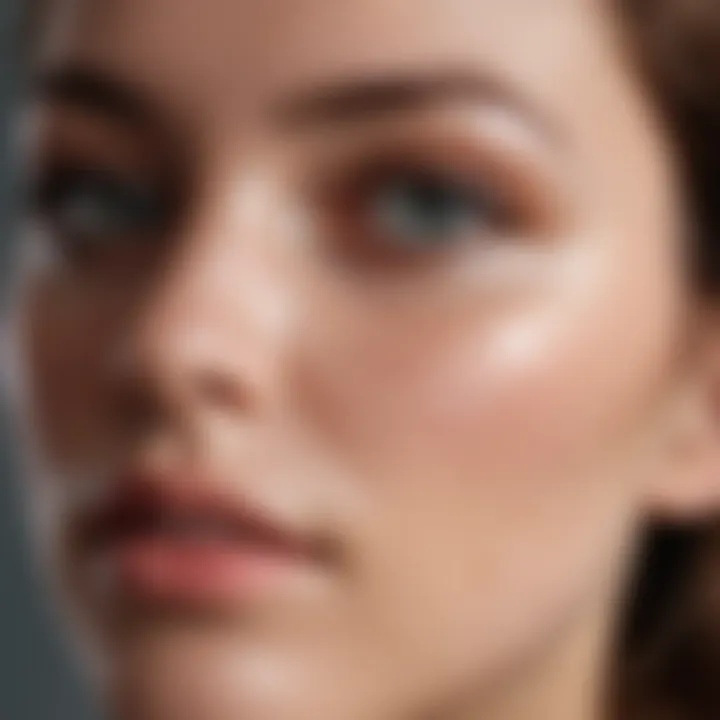Ultimate Skin Care Routine to Eliminate Whiteheads


Intro
Whiteheads can be a frustrating skin concern for many individuals. These small, white bumps typically appear when pores are clogged with excess oil, dead skin cells, and bacteria. Unlike blackheads, which are open to the air and turn dark, whiteheads remain closed, creating a challenging situation for those seeking a clear complexion. Both genetics and lifestyle play a significant role in their development, making it crucial to understand the underlying causes to adopt effective preventative measures.
In this comprehensive guide, we will delve into the skincare routine specifically designed to manage and reduce whiteheads. You will learn about the nature of whiteheads, how they form, and what lifestyle choices can influence their appearance.
Additionally, we will explore a range of skincare products tailored for this purpose, analyze their key ingredients, and provide insights into the proper usage techniques. Emphasizing a holistic approach, this narrative aims to empower you with the knowledge to maintain healthy skin, especially if whiteheads have been a persistent issue. Stay tuned for the detailed sections ahead.
Causes of Whiteheads
Understanding what causes whiteheads is vital in combating them effectively. Common factors include:
- Excess Oil Production: Overactive sebaceous glands can lead to an accumulation of oil on the skin.
- Hormonal Changes: Fluctuations during menstrual cycles or due to certain medications can increase oil production.
- Poor Skincare Practices: Using heavy, comedogenic products can clog pores, contributing to whitehead formation.
- Dietary Choices: High-glycemic foods and dairy have been linked to acne-related issues, including whiteheads.
By identifying these triggers, one can more effectively tailor a skincare regimen to address and prevent whiteheads.
Skincare Routine for Whiteheads
A structured skincare routine is essential in managing and preventing whiteheads. Here, we break down each step:
Cleanser
Choosing the right cleanser is the first step in your routine. Opt for a gentle, salicylic acid-based cleanser that can help remove excess oil and dirt without stripping the skin.
Exfoliation
Regular exfoliation is key. Incorporate a chemical exfoliant, such as glycolic acid, 2-3 times a week. This helps to remove dead skin cells that can clog pores.
Toner
A toner with witch hazel or tea tree oil can assist in balancing the skin's oil levels and provide additional antibacterial properties.
Treatment Products
Consider using treatments with benzoyl peroxide, which targets bacteria, or retinoids to promote cell turnover and prevent clogged pores. It's important to start slowly to avoid irritation.
Moisturizer
Even if you have oily skin, do not skip moisturizer. Select a lightweight, non-comedogenic product to ensure hydration without clogging pores.
Sun Protection
Always finish with a broad-spectrum sunscreen during the daytime. Protecting your skin from UV damage prevents further complications.
Lifestyle Insights
Changing certain lifestyle habits can also enhance your skincare routine:
- Hydration: Drink plenty of water to keep your skin hydrated from within.
- Diet: Focus on a moderate, balanced diet rich in whole foods, fruits, and vegetables.
- Stress Management: Stress can impact skin health, so consider practices like yoga or meditation.
These small changes can make a significant difference in your skin's overall appearance.
End
Understanding Whiteheads
Understanding whiteheads is crucial for developing an effective skin care routine. Whiteheads are a common form of acne that can disrupt a person's skin appearance and confidence. The importance of identifying and treating them cannot be overstated, as failing to do so can lead to further skin issues. By comprehending the nature of whiteheads, you can tailor your skin care practices more effectively. This section will delve into the definition, characteristics, and differentiation between whiteheads and other types of acne. These insights will equip you with the knowledge to make informed choices in skin care products and routines.
Definition and Characteristics
Whiteheads, scientifically known as closed comedones, appear as small, white or flesh-colored bumps on the skin. They occur when hair follicles become clogged with oil, dead skin cells, and bacteria. Unlike blackheads, which have open comedones and present as dark spots on the skin’s surface, whiteheads are fully blocked. Characteristics of whiteheads include:
- Small Size: Typically, whiteheads are less than a few millimeters in diameter.
- White or Flesh-Colored Appearance: They often look like tiny white bumps, making them more challenging to conceal.
- Location: Whiteheads can develop anywhere but are most commonly found on the face, particularly on the forehead, chin, and nose.
Whiteheads may not always lead to inflammation, but they can become red and itchy if not properly addressed. It is essential to recognize these characteristics to differentiate them from other skin issues.
Difference Between Whiteheads and Other Acne Types
Understanding how whiteheads differ from other types of acne is vital for effective treatment. Here are some key comparisons:
- Blackheads: Unlike whiteheads, blackheads are open at the surface. They appear black due to oxidation in the clogged pore.
- Papules: These are small, raised red bumps that often signify inflammation. Unlike whiteheads, papules do not have a visible center or pus.
- Pustules: Also known as pimples, these contain pus and are red at the base. They may accompany whiteheads and indicate inflammation.
- Cysts: Cystic acne is deeper and more severe. Cysts are painful and filled with pus, often resulting in scarring if untreated.


It is critical to identify these differences for proper management. Whiteheads can often be treated with a simple skin care routine, while other types may require a more intensive approach.
"Understanding the distinction between different acne types empowers individuals to choose the right treatments and avoid unnecessary skin damage."
By comprehending whiteheads, you can create a proactive, targeted skin care routine, setting the foundation for healthier skin.
Causes of Whiteheads
Understanding the causes of whiteheads is crucial for developing an effective skin care routine. Whiteheads are a form of acne that results when hair follicles become clogged with oil, dead skin cells, and bacteria. Recognizing the specific elements that lead to their formation can help prevent future breakouts and promote a clearer complexion. Addressing the root causes rather than just the symptoms can yield long-term benefits, making it an essential focus in skin care management.
Excess Oil Production
Excess oil production is one of the primary culprits behind the formation of whiteheads. The sebaceous glands in our skin generate sebum, which is necessary for hydration and protection. However, when these glands become overactive, they can produce too much oil. Various factors contribute to this overproduction, including hormonal changes, high humidity, and an unhealthy diet. When oil combines with dead skin cells, it can trap dirt and bacteria, leading to clogged pores.
To manage excess oil, consider using products specifically designed for oily skin. Non-comedogenic moisturizers and oil-free cleansers can help. Frequent cleansing, ideally twice a day, is also key to controlling oil levels. Adopting the right lifestyle ��— such as maintaining a balanced diet — enhances skin health and may reduce oil production significantly.
Clogged Pores
Clogged pores are another significant factor leading to whiteheads. When the skin's natural shedding process does not occur fully, dead skin cells can accumulate and mix with sebum. This mixture creates a blockage in the hair follicle. Environmental factors, such as pollution or the use of heavy makeup, can exacerbate this issue.
Regular exfoliation can help prevent clogged pores. Using products that contain salicylic acid can penetrate the pores and dissolve dead skin cells effectively. Choose gentle exfoliants to minimize skin irritation. It is also essential to remove makeup thoroughly before bedtime to ensure the skin can breathe and regenerate overnight.
Bacteria and Skin Flora Imbalance
Bacteria play a crucial role in acne formation, including whiteheads. Cutibacterium acnes, a type of bacteria found on the skin, can proliferate when conditions become suitable due to excess oil and clogged pores. An imbalance in the skin's flora can worsen the situation, leading to inflammation and acne.
To control bacterial growth, it is beneficial to incorporate antibacterial ingredients into your skin care routine. Products with benzoyl peroxide or salicylic acid can help manage bacterial levels and reduce inflammation. Additionally, avoiding harsh products that strip the skin of its natural oils can preserve the healthy balance of skin flora.
Regularly monitor your skin and adjust your routine as needed to maintain its health.
Key Components of a Skin Care Routine
A well-structured skin care routine is crucial for managing whiteheads effectively. Each step plays a significant role in maintaining skin health and preventing further breakouts. This section outlines the essential components, emphasizing their importance and the specific benefits they offer.
Cleansing
Choosing the Right Cleanser
Selecting the correct cleanser is vital for clear skin, particularly when tackling whiteheads. A good cleanser removes excess oils and impurities without stripping the skin of its natural moisture. Gel or foaming cleansers are often effective because they thoroughly cleanse the skin. Look for ingredients like salicylic acid, which help to penetrate pores and dissolve excess oil. A proper cleanser can set the tone for the entire routine, making it easier for subsequent products to work effectively.
However, those with sensitive skin should be cautious. A harsh cleanser might aggravate the skin, leading to more breakouts.
Frequency of Cleansing
Understanding the frequency of cleansing is equally important. Ideally, one should cleanse twice daily—morning and night. This helps eliminate dirt and oils that accumulate throughout the day and while sleeping. Cleansing in the morning preps the skin for the application of other products, making them more effective. While it may be tempting to overcleanse, doing so can irritate the skin, disrupting its natural barrier.
Exfoliation
Types of Exfoliants
Exfoliation is a key step in a skin care routine aimed at whiteheads. There are two main types: mechanical and chemical exfoliants. Mechanical exfoliation involves physical scrubs, while chemical exfoliants utilize acids like lactic or glycolic acid to dissolve dead skin cells and promote cell turnover. Chemical exfoliants may be more effective for those struggling with whiteheads. They can prevent clogged pores and enhance overall skin texture without the risk of irritation associated with scrubs. Be mindful to choose the type that best suits your skin type to avoid negative effects.
How Often to Exfoliate
The frequency of exfoliation should align with your skin's needs. For most skin types, exfoliating once or twice a week is sufficient. Over-exfoliation can lead to sensitivity and increased oil production as the skin tries to compensate for the loss of its protective layer. Pay attention to your skin's response. Adjusting frequency based on condition is key.
Toning
Purpose of Toning
Toning is an often-overlooked step in many routines. A toner can restore the skin's pH after cleansing and help remove any leftover impurities. Additionally, it can hydrate and prepare the skin for products that follow. With the right toner, one can enhance the effectiveness of serums and moisturizers by improving absorption.
Best Ingredients for Toning
Choosing the right ingredients in a toner is crucial. Look for alcohol-free toners enriched with witch hazel or rose water, which balance oil production without drying out the skin. Natural ingredients can provide hydration, making them beneficial for maintaining overall skin health. Avoid toners with high alcohol content, as they may create more problems than solutions.
Moisturizing
Selecting Non-Comedogenic Products
Moisturizing is essential, even for oily skin types. Opt for non-comedogenic products, which are designed not to clog pores. Lightweight formulas that absorb quickly are ideal. Ingredients such as hyaluronic acid can hydrate the skin without contributing to breakouts. A good moisturizer maintains skin integrity while preventing excessive oiliness.


Balancing Oil Production
Balancing oil production is crucial in preventing whiteheads. A moisturizer that offers hydration without heaviness can help. Moreover, incorporating ingredients that regulate sebum production can further support this goal. Doing so maintains skin's moisture without triggering breakouts.
Targeted Treatments
Spot Treatments
Spot treatments are an effective way to address individual whiteheads. Formulations that contain benzoyl peroxide or tea tree oil target specific blemishes, helping to reduce inflammation and promote healing. These treatments can work quickly, making them important in any routine aimed at managing breakouts.
Serums and Active Ingredients
Incorporating serums with active ingredients can enhance a skin care routine. Serums containing salicylic acid or niacinamide can help to reduce the appearance of pores and prevent breakouts. The use of such targeted ingredients can support a clearer, healthier complexion over time.
By understanding and properly implementing these key components, one can develop a skin care routine that effectively combats whiteheads and supports long-term skin health.
Product Recommendations
The importance of product recommendations in managing whiteheads cannot be overstated. Selecting the right skincare products plays a crucial role in effectively minimizing and preventing the formation of whiteheads. Each skin type has its unique demands, and thus, the formulations need to cater to these specific requirements. These recommendations are tailored to help individuals achieve and maintain clear skin through informed choices.
Cleansers
Best Foaming Cleansers
Best foaming cleansers are particularly effective in deep-cleaning the skin. They help to remove excess oil and impurities, which can clog pores and lead to whitehead formation. A major characteristic of these cleansers is their ability to create a rich lather that penetrates the skin effectively. This makes them a popular option for those dealing with oily and combination skin types.
One unique feature of foaming cleansers is that they often contain ingredients like salicylic acid, which targets acne. The benefits include a thorough cleanse without leaving the skin feeling overly stripped. However, they might not be the best choice for those with dry or sensitive skin, as the strong formula can lead to irritation.
Gentle Cream Cleansers
Gentle cream cleansers offer a mild and soothing solution for those with sensitive skin or existing breakouts. They are designed to cleanse without disrupting the skin’s natural moisture barrier. The key characteristic is their creamy consistency, which often includes hydrating ingredients. This makes them suitable for a broader audience, especially for those who experience redness or irritation easily.
What sets gentle cream cleansers apart is their ability to cleanse while imparting moisture to the skin. Advantageously, they provide a soft touch that still removes dirt and makeup effectively, avoiding the harshness of some foaming options. Nonetheless, this format might leave a residue for individuals with oilier skin types, which can sometimes aggravate breakouts.
Exfoliants
Choosing Chemical Exfoliants
Choosing chemical exfoliants is a strategic decision in any skincare routine targeting whiteheads. These products work by using acids that break down dead skin cells. The key characteristic is their ability to provide a deeper clean than physical scrubs, effectively preventing clogged pores.
They are beneficial because they often contain ingredients such as glycolic or lactic acid, which can improve overall skin texture and tone. A unique feature is that they can deliver noticeable results with consistent use over time. However, care needs to be taken, as overuse can lead to irritation or even further breakouts.
Physical Exfoliants Not to Overuse
While physical exfoliants can provide immediate benefits by manually sloughing away dead skin, it is essential to approach their use with caution. The key characteristic of these products is their grainy texture, which can help to polish the skin.
They can be appealing due to their instant results; however, the repeated friction can lead to micro-tears in the skin. This makes it a good practice to limit their use to once a week or less to avoid diminishing the skin’s natural barrier. Misuse can contribute to worsened acne or irritation, particularly in delicate areas.
Toners
Alcohol-Free Toners
Alcohol-free toners are critical in a skincare routine for maintaining hydration without the risk of drying out the skin. Their key characteristic is the absence of alcohol, making them gentler on sensitive and acne-prone skin types.
Being alcohol-free, they serve to balance the skin's pH and prepare it for subsequent product application. A unique advantage is that these toners often include soothing ingredients like aloe or chamomile. However, care should be taken with those who misuse toners, as they may overuse them in hopes of drying out their skin.
Toners with Astringent Properties
Toners with astringent properties can be particularly advantageous for those with oily skin. These toners are designed to tighten pores and reduce oiliness, which can help in preventing whiteheads. The key characteristic is their content of ingredients like witch hazel, which provides a cooling and refreshing feeling.
Their unique feature is the ability to remove residual oils and impurities post-cleansing, making the skin feel clean and fresh. However, excessive use can lead to over-drying, which can trigger increased oil production, ultimately leading to more breakouts.
Moisturizers
Lightweight Formulas
Lightweight formulas are essential in a skincare routine as they hydrate without overwhelming the skin. Their key characteristic is their ability to absorb quickly and not leave a greasy residue. This makes them especially appealing to individuals prone to whiteheads.
Being non-comedogenic, these moisturizers provide essential hydration without clogging pores, making them ideal for oily skin types. However, it is crucial to ensure that the formulas selected align with hydration needs, as inadequate moisture can trigger the skin to produce more oil.
Hydrating Ingredients like Hyaluronic Acid
Hydrating ingredients such as hyaluronic acid are integral to keeping the skin balanced. The key characteristic of hyaluronic acid is its ability to draw in moisture and retain it within the skin. This characteristic makes it a beneficial addition to any moisturizer.
What sets hyaluronic acid apart is its lightweight nature, allowing for deeper penetration without feeling heavy. However, one must be cautious, as relying solely on its presence without adequate emollients may not provide sufficient hydration for those with very dry skin.
Acne Treatments
Benzoyl Peroxide
Benzoyl peroxide is a well-known treatment in acne care, specifically effective for whiteheads. Its key characteristic is its ability to kill bacteria on the skin, preventing future breakouts. Additionally, it helps reduce inflammation, making it a robust choice for many.
A unique feature of benzoyl peroxide is its availability in various strengths, giving users flexibility based on their skin's tolerance. However, a downside can be dryness or irritation, especially with higher concentrations, necessitating careful use.
Salicylic Acid
Salicylic acid is another powerful ingredient known for its ability to treat whiteheads. Its key characteristic is its properties as a beta hydroxy acid (BHA), which penetrates the pores and exfoliates internally.
This internal exfoliation enables salicylic acid to effectively dissolve buildups that lead to whiteheads. One unique bonus is its anti-inflammatory properties, which can reduce redness associated with acne. However, there is a need for caution with overuse, as it can lead to excessive drying of the skin.
Lifestyle Considerations


Lifestyle plays a crucial role in the effective management of whiteheads. While topical treatments are essential, a holistic approach that incorporates changes in daily habits can significantly improve skin health. Factors such as diet, stress management, and sleep quality are interconnected with skin conditions, making them vital components of any skincare routine.
Dietary Choices
Foods That Might Trigger Breakouts
Certain foods can lead to an increase in whiteheads. High-glycemic-index foods like white bread, pastries, and sugary snacks can cause a spike in insulin levels, promoting oil production in the skin. Dairy products may also contribute to breakouts, as some studies suggest that hormones present in milk can disrupt skin balance. Avoiding these trigger foods can lead to clearer skin. This awareness is critical for those struggling with acne-related issues.
Importance of Hydration
Hydration is essential for maintaining skin elasticity and health. Adequate water intake helps to flush out toxins and ensures the skin remains plump and hydrated. The unique feature of hydration is its ability to affect the skin from the inside. A well-hydrated body can more effectively combat issues like inflammation. Aim for at least eight 8-ounce glasses of water daily to support your skin's needs.
Stress Management
Impact of Stress on Skin Health
Stress is a notorious trigger for skin conditions, including whiteheads. When the body is under stress, cortisol levels rise, leading to increased oil production and, consequently, clogged pores. Recognizing this connection is essential for anyone looking to improve their skin condition. Managing stress can have a direct positive effect on skin appearance, making it a significant focus in a skincare routine.
Effective Stress Reduction Techniques
Incorporating stress-reduction techniques is beneficial for overall skin health. Methods such as mindfulness, yoga, and regular exercise can lower stress levels. These techniques not only improve mental well-being but can also enhance skin appearance by reducing the likelihood of stress-related breakouts. Making time for such activities can yield noticeable results.
Sleep and Skincare
Establishing a Sleep Schedule
Sleep regulates various bodily functions, including skin repair processes. Establishing a consistent sleep schedule helps in maintaining hormonal balance and reducing stress, both of which are beneficial for preventing whiteheads. The key is to aim for seven to nine hours of quality sleep each night. Creating a calming bedtime routine will help support this goal.
Benefits of Quality Sleep for Skin Regeneration
Quality sleep facilitates skin regeneration. During deeper sleep stages, the body focuses on healing and repairing tissues. This is when the skin cells regenerate and rejuvenate. A lack of sleep can hinder this process, leading to dull skin and acne flare-ups. Therefore, prioritizing sleep can result in significant improvements in skin health and appearance.
Maintaining an optimal lifestyle, including dietary awareness, stress management, and consistent sleep, builds a strong foundation for skincare. Taking these factors into account can help effectively manage whiteheads.
Common Mistakes to Avoid
In the journey to achieve clear skin, avoiding common mistakes is crucial. These errors can hinder progress and exacerbate whitehead issues. Understanding these pitfalls allows for a more effective skincare routine, which in turn promotes a clearer complexion. By actively dodging these missteps, one can enhance the effectiveness of treatments and maintain skin health more efficiently.
Over-Exfoliation
Exfoliation is a key step in managing whiteheads, yet many individuals mistakenly overdo it. While regular exfoliation can help remove dead skin cells and unclog pores, excessive scrubbing can lead to irritation and skin barrier damage. The aftermath of over-exfoliation includes redness, increased sensitivity, and potentially an uptick in breakouts due to compromised skin integrity. It is advisable to limit exfoliation to two to three times per week, opting for milder formulations when possible. Gentle chemical exfoliants like glycolic acid can be beneficial, but always be cautious about combining too many active ingredients.
Ignoring Sun Protection
Sun protection is often underestimated in skincare routines. Many individuals neglect to apply sunscreen daily, thinking it is unnecessary unless they are outdoors for extended periods. However, exposure to UV rays can degrade skin quality and lead to more pronounced whiteheads. Sunscreen helps protect against inflammation and darkening of spots caused by the sun. A broad-spectrum sunscreen with at least SPF 30 should be used every day as part of a routine. Additionally, chemical sunscreens may irritate sensitive skin types, so choosing mineral options, like those containing zinc oxide or titanium dioxide, may be more suitable.
Using Harsh Products
The temptation to use strong, harsh products to combat whiteheads can often backfire. People may resort to aggressive cleansers or astringents, mistakenly believing that they will efficiently purge oil and debris. However, these products can strip the skin of its natural oils, leading to an overproduction of oil and, ultimately, more breakouts. It is essential to select gentle, pH-balanced cleansers and avoid products laden with alcohol, fragrances, or adverse ingredients. Instead, focus on using non-comedogenic products that maintain moisture without contributing to pore blockage.
"The key to effective skincare is understanding what your skin truly needs and avoiding unnecessary aggressiveness."
Being aware of these common mistakes empowers individuals to refine their skincare practices. By fostering habits that respect skin health, one can achieve more consistent and satisfying results in the battle against whiteheads.
Monitoring and Adjusting Your Routine
To achieve optimal results in managing whiteheads, it's crucial to monitor and adjust your skin care routine regularly. Understanding that skin reacts differently to products and external factors will help you refine your approach. Keeping track of how your skin responds to various treatments can lead to a more effective routine over time.
Monitoring involves observing changes in the skin. Improvements may indicate that your chosen products are working, while adverse reactions can signal the opposite. For instance, if you notice your skin becoming excessively dry or irritated, it might be time to reassess your cleansing or exfoliation practices. This process is about finding a balance that suits your unique skin type and its needs.
Additionally, your skin condition can change due to various factors including hormonal fluctuations, seasonality, and stress levels. Therefore, being adaptive is essential. Embracing flexibility in your routine allows you to address these changes, ensuring that you maintain healthy skin while effectively combating whiteheads.
Regular evaluations can help you refine your regimen. Start a journal to document product usage, skin reactions, and any improvements. This written record will be beneficial in recognizing patterns and making informed decisions. It also encourages you to be proactive rather than reactive when your skin shows signs of distress.
Signs of Improvement
Identifying signs of improvement is key to knowing whether your routine is effective. Several indicators can help you assess progress:
- Reduced Whiteheads: Less frequent appearance of whiteheads is a positive sign. It indicates successful management through your routine.
- Smoother Skin Texture: If your skin feels less bumpy and more even, it suggests that your exfoliation and cleansing practices are helping.
- Balanced Oil Levels: A decrease in oiliness is another indicator of improvement, signaling that your current products are working effectively to control excess oil.
- Less Inflammation: Reduced redness or irritation means your skin is responding well to the ingredients in your routine. Products that soothe rather than aggravate are critical here.
Using these signs, you can evaluate if adjustments are needed. If no signs of improvement appear after a reasonable timeframe, consider changing some products or consulting more specific guidance based on your skin's needs.
When to Seek Professional Help
Sometimes, home treatments may not be sufficient. Knowing when to seek professional help is crucial, especially if you experience:
- Severe Breakouts: Frequent or persistent whiteheads despite a disciplined routine may require a dermatologist’s insight.
- Painful Cysts: If you develop painful cystic acne, it's essential to consult a healthcare professional for treatment.
- Allergic Reactions: Signs of severe irritation or allergic reactions to products necessitate professional evaluation to find safe alternatives.
- Lack of Improvement: If you notice no changes after a few weeks, experts can provide tailored advice or medications more suited to your skin type.
Regardless of your skin's condition, a professional can offer targeted treatments, such as prescription medications or professional interventions to enhance your skin’s health. Keeping your skin care journey adaptable and informed will help in achieving long-lasting results.



